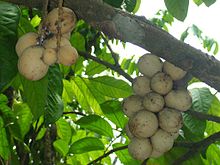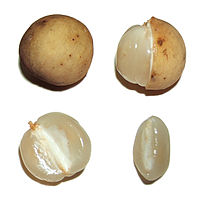 |
| Langsat fruits hanging at the branches of tree |
Lansium domesticum or Duku, Dokong and Langsat are the species of fruits-bearing tree belonging to the family Meliaceae.
 It is a medium-sized, single-trunked tree that usually grows from ten to fifteen meters tall. The plant has pinnately compound leaves that grow to a length of around twenty to fifty centimeters long per leaf. Each fully-grown leaf has five to seven slightly-leathery, obovate leaflets that can reach a length of twenty centimeters each. A very prominent midrib bisects each dark green, glossy leaflet.
It is a medium-sized, single-trunked tree that usually grows from ten to fifteen meters tall. The plant has pinnately compound leaves that grow to a length of around twenty to fifty centimeters long per leaf. Each fully-grown leaf has five to seven slightly-leathery, obovate leaflets that can reach a length of twenty centimeters each. A very prominent midrib bisects each dark green, glossy leaflet.L. domesticum flowers are hermaphrodite, having both stamen and pistil structures in the same flower. The pale-yellow, fleshy flowers are found in inflorescences of around thirty blossoms, in most cases in a raceme usually around thirty centimeters long.
 Fruits are ovoid, roundish orbs around five centimeters in diameter, usually found in clusters of two to thirty fruits along the branches and trunk. Each round fruit is covered by yellowish, thick, leathery skin. Underneath the skin, the fruit is divided into five or six slices of translucent, juicy flesh.
Fruits are ovoid, roundish orbs around five centimeters in diameter, usually found in clusters of two to thirty fruits along the branches and trunk. Each round fruit is covered by yellowish, thick, leathery skin. Underneath the skin, the fruit is divided into five or six slices of translucent, juicy flesh.The flesh is slightly acidic in taste, although ripe specimens are sweeter.
Green seeds are present in around half of the segments, usually taking up a small portion of the segment although some seeds take up the entire segment's volume. In contrast with the sweet-sour flavor of the fruit's flesh, the seeds are extremely bitter. The fruit taste has been compared to a combination grape and "perfect" grapefruit with no bitterness. Yet the seeds if bitten have the bitterness of a grapefruit yet stronger. The sweet juicy flesh contains sucrose, fructose, and glucose.
 |
| duku fruit |
Lansium duranum was originally native to the Malaysian peninsula and known locally as Langsat. Agriculturally, the tree is grown throughout the entire Southeast asian region, ranging from Southern India to the Philippines for its fruit. In the Philippines, where it is locally referred to as the lanzones or langsa, the plant is grown mostly on the southern parts of the island of Luzon, especially in Paete, Laguna, due to the species' narrow range of conditions favorable to its survival. It is also found in abundance on Northern Mindanao particularly in places as Butuan, Cagayan de Oro, and Camiguin. The Camiguin variety is especially sweet and succulent.
 |
| duku |
In Indonesia, Langsat is very popular fruit in West Kalimantan (Pontianak, Indonesia) and South Sumatra (also called 'Duku'). In Sarawak, northern Borneo, the name Duku is reserved for the larger-sized varieties of Langsat, near the size of golf balls, claimed sweeter and with less sap in the peel. A variety called Dokong exported to mainland Malaysia from Thailand grows tighter in the clusters, giving it a faceted shape, and is preferred by many over the standard Langsat.
 |
| langsat |
Within mainland Asia, the tree is cultivated in Thailand ( langsat), Cambodia, Vietnam and India, as well as its native Malaysia. Outside the region, it has also been successfully transplanted and introduced to Hawaii and Surinam. It grows well in the wetter areas (120 inches/3 meters or more annual rainfall) of Costa Rica, where it is still very rare, having been introduced decades ago by the United Fruit Company. A major hindrance to its acceptance seems to be that it is very slow in bearing, said to take 12 years from seed. However, air layering from mature trees, as well as grafting, are said to work well and produce much faster.
 |
| dokong fruit |
It grows wild in Sumatra forests where a wide and longest river in Indonesia lay across the southern part of Sumatra. The river rises and floods the forest lands for a few months, when it subsides, the flood leaves plenty of fallen leaves and twigs enriching and moistening a large area of the forest bed, resulting in ideal conditions for the plant to grow naturally. Local people will come and harvest it as natural forest produce. They climb up the tree with ripe fruits (after observing it), holding with their hands on the smaller branches and shaking it. Mature fruits will fall easily down to the ground. They will then collect it and transport it on a small boat on a nearby river to the villages and sell it. In a good year a 20-year old tree can produce 100 kg of fruits, however fruiting is often uneven.
 |
| dokong fruits hanging on trees |
It is known variously as langsat (Malay); lansones , lansa, langseh, langsep, lanzon, lanzone, lansone(Filipino); langsad (for the type of which its skin is quite sticky to the fruit), longkong (for the type of which the skin is easily peeled off without milky latex) (Thai); duku, langsat, kokosan (Indonesian), Gadu Guda (Sri Lanka), lòn bon and bòn bon (Vietnamese). In certain parts of the Visayas, the fruit is called buwa-buwa or bowa-bowa, and the tree is called buwahan or bowahan.
 |
| langsat fruits, not much different with dokong isn't it? |
| and so the duku? |
Langsat fruits are usually eaten fresh, but may be canned in syrup. Seedless sections can be dried like raisins, which is done in the Philippines. Nutritional composition per 100 g langsat fruit Carbohydrate 7.8-14.2 g Protein 0.4-0.7 g Calcium 10–19 mg Phosphorus 20 mg Iron 1 mg Thiamine 0.05 mg Riboflavin 0.02 mg Niacin 0.5 mg Vitamin C 4-13.4 mg.
 |
| duku |
 |
| langsat |
| and dokong |
Several parts of the plant have medicinal uses. The fruit peel is dried and burned to repel mosquitoes; it is also used to treat intestinal parasites and diarrhea. Powdered seeds are used to reduce fever, and the bark is used to treat malaria and scorpion stings.








No comments:
Post a Comment